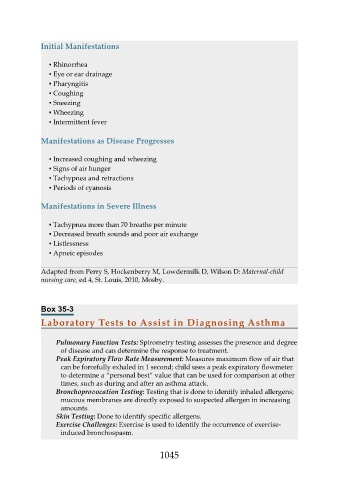Page 1045 - Saunders Comprehensive Review For NCLEX-RN
P. 1045
Initial Manifestations
▪ Rhinorrhea
▪ Eye or ear drainage
▪ Pharyngitis
▪ Coughing
▪ Sneezing
▪ Wheezing
▪ Intermittent fever
Manifestations as Disease Progresses
▪ Increased coughing and wheezing
▪ Signs of air hunger
▪ Tachypnea and retractions
▪ Periods of cyanosis
Manifestations in Severe Illness
▪ Tachypnea more than 70 breaths per minute
▪ Decreased breath sounds and poor air exchange
▪ Listlessness
▪ Apneic episodes
Adapted from Perry S, Hockenberry M, Lowdermilk D, Wilson D: Maternal-child
nursing care, ed 4, St. Louis, 2010, Mosby.
Box 35-3
Laboratory Tests to Assist in Diagnosing Asthma
Pulmonary Function Tests: Spirometry testing assesses the presence and degree
of disease and can determine the response to treatment.
Peak Expiratory Flow Rate Measurement: Measures maximum flow of air that
can be forcefully exhaled in 1 second; child uses a peak expiratory flowmeter
to determine a “personal best” value that can be used for comparison at other
times, such as during and after an asthma attack.
Bronchoprovocation Testing: Testing that is done to identify inhaled allergens;
mucous membranes are directly exposed to suspected allergen in increasing
amounts.
Skin Testing: Done to identify specific allergens.
Exercise Challenges: Exercise is used to identify the occurrence of exercise-
induced bronchospasm.
1045

